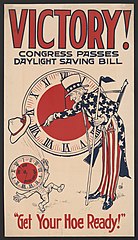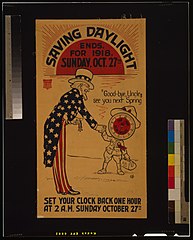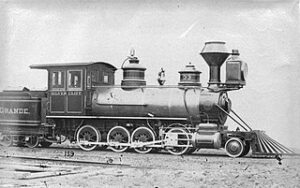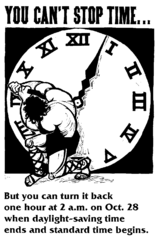
Do you have a traditional clock or watch? Did you remember to push time back an hour? If you use a smart device to find “tell” time, the change happened automatically. If, like me, you still wear an old-fashioned watch, the adjustment requires a bit more attention.
Daylight Saving happens twice every year, forward in the spring and backward in the fall, for no apparent reason. And, usually, I don’t pay much attention to it, because I live in Hawai`i, one of two states where time doesn’t change. This year, when everything seems out of control, pushing time back an hour is a conceptual change many of us could do without. As a lapsed historian, I’m compelled to find the source of this strange custom.

It turns out Daylight Saving started as a war measure in World War I. Germany was the first to move clocks forward on May 1, 1916, as a way to save electricity and provide more daylight hours for factory work, like making munitions.
Before the United States even entered the war in April 1918, Congress passed the Standard Time Act on March 19. Americans marched Time forward on March 31. On October 27, Time reverted to “normal,” though the war continued until November 11.

Many Americans didn’t like the extra hour of daylight. Farmers famously pointed out that cows can’t tell time, which meant they had to be milked in the dark pre-dawn hours. Americans happily existed on standard time until World War II, when President Roosevelt introduced War Time. Americans saved daylight for the entire war until September 30, 1945.
After that, there was no national time policy. In 1965, 18 states saved daylight for six months of the year; 12 states didn’t. The remaining 18 states let individual counties and/or cities mark time however local government chose.

This lack of standardization troubled the transportation industry, the same entity that created standard time zones. In the late 19th century, the United States had several transcontinental railroad lines, and needed accurate timetables. With every region setting its own time, railroad planners couldn’t accurately document when a train would arrive or leave. So, on November 18, 1883 American railroads began using a standard time system that divided the nation into the four time zones we have today: Eastern, Central, Mountain, and Pacific. This became law as part of the 1918 Standard Time Act that introduced daylight saving.

Time zones were helpful, but not if states within time zones kept different times. This brought about the Uniform Time Act of 1966, which scheduled when Americans would use Standard Time and when they would use Daylight Time. There was an initial provision that allowed states to opt out. Hawai`i never opted for Daylight Saving Time. In Arizona, the Navajo Nation uses Daylight Saving Time, but not the rest of the state.
Jumping ahead, the 2005 Energy Policy Act established the second Sunday in March as the day to start saving daylight and the first Sunday in November as the day to stop. The U.S. Chamber of Commerce reported that up until this year, the longer daylight hours meant more Americans shopped after work, and the golf industry had an increase in revenue.

There are drawbacks to Daylight Saving Time. Changing time impacts sleep patterns and harms health. Some statistics cite more crime and more traffic fatalities caused by driving in the dark. And if the point of saving daylight is to reduce the use of electricity, there’s no proof this is true, since people use electricity for heating and cooling.

In 2018 California voters granted their legislature the power to stop altering time. Florida passed a Sunshine Protection Act. Washington, Oregon, Tennessee, Nevada, and Alabama have also oped to keep the same time. None of these actions has the force of law, because only Congress can control American time. I doubt this is a pressing issue on the national agenda. Meanwhile, we’ll spring forward again on March 14, 2021. I hope by then we’ll have a spring in our step as well as our daylight hours.
⏰⏰⏰
*The Armistice ending World War I began on Nov. 11, 1918
Illustrations
Opening Meme by Author.
Victory
Saving Daylight Ends for 1918
Narrow Gauge Locomotive, 1885
You Can’t Stop Time
Yawning emoji face by alleZSoyez
Changing U.S. Senate Clock. 1918.
Steve Chapman. “We’ll Soon Go Off Daylight Saving Time.” Lowell Sun. Oct 10, 2020
Elizabeth Nix. “When Did the United States Start Using Time Zones?” History.
Jen Smith. “Changing Clocks is a Bad Idea.” CNN Health. Sept 3, 2020

Sandra Wagner-Wright holds the doctoral degree in history and taught women’s and global history at the University of Hawai`i. Sandra travels for her research, most recently to Salem, Massachusetts, the setting of her new Salem Stories series. She also enjoys traveling for new experiences. Recent trips include Antarctica and a river cruise on the Rhine from Amsterdam to Basel.
Sandra particularly likes writing about strong women who make a difference. She lives in Hilo, Hawai`i with her family and writes a blog relating to history, travel, and the idiosyncrasies of life.

